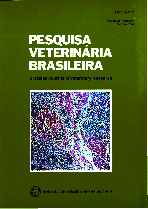 |
|
|
|
Year 2001 - Volume 21, Number 4
|

|
Equine pythiosis in the Brazilian Pantanal region: Clinical and pathological findings of typical and atypical cases, 21(4):151-156
|
ABSTRACT.- Leal A.B.M., Leal A.T., Santurio J.M., Kommers G.D. & Catto J.B. 2001. [Equine pythiosis in the Brazilian Pantanal region: Clinical and pathological findings of typical and atypical cases] Pitiose eqüina no Pantanal brasileiro: aspectos clínico-patológicos de casos típicos e atípicos. Pesquisa Veterinária Brasileira 21(4):151-156. Laboratório de Pesquisas Micológicas, Depto Microbiologia e Parasitologia, Universidade Federal de Santa Maria, 97105- 900 Santa Maria, RS, Brazil. E-mail: santurio@ccr.ufsm.br
Equine pythiosis is an endemic disease of horses and causes significant economic losses to equine breeding in the Brazilian Pantanal. This article describes 16 cases of subcutaneous pythiosis in horses from that region. The clinical cases were divided in typical (11) and atypical (5), according to the clinical features and duration of the disease. The clinical diagnosis was confirmed by detection of specific antibodies by ELISA, isolation of the agent and histopathology. The duration of the disease varie d from 1 to 6 months in the typical cases and was over 12 months in the atypical ones. The lesions in the typical cases were characterized by subcutaneous ulcerated granulomas with abundant serosanguineous secretion and itching. The atypical cases presented subcutaneous lesions characterized by large, circumscribed tumorous masses covered by a dark non ulcerated skin, associated with Iittle orno secretion. These lesions showed a well organized aspect, were sometimes pedunculate and the animals showed a good body condition. Histologically, the typical cases were characterized by granulation tissue with abundant eosinophils; whereas the atypical cases presented pseudoepitheliomatous hyperplasia of the epidermis and eosinophilic infiltrate. The complete description of the clinical and histopathological features and possible factors responsible for differences between the two clinical forms are presented and discussed. |
| |
|
|
| |
|
 |